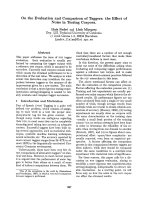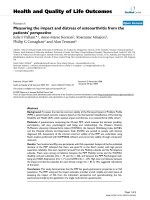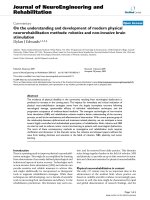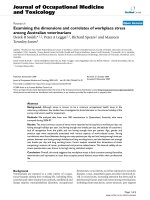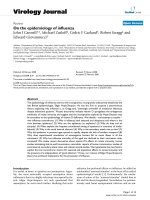Báo cáo hóa học: " On the understanding and development of modern physical neurorehabilitation methods: robotics and non-invasive brain stimulation" pdf
Bạn đang xem bản rút gọn của tài liệu. Xem và tải ngay bản đầy đủ của tài liệu tại đây (198.53 KB, 4 trang )
BioMed Central
Page 1 of 4
(page number not for citation purposes)
Journal of NeuroEngineering and
Rehabilitation
Open Access
Commentary
On the understanding and development of modern physical
neurorehabilitation methods: robotics and non-invasive brain
stimulation
Dylan J Edwards
1,2,3,4
Address:
1
Burke Medical Research Institute, White Plains, NY, USA,
2
Department of Neurology & Neuroscience, Weill Medical College, Cornell
University, White Plains, NY, USA,
3
Berenson-Allen Center for Non-Invasive Brain Stimulation, Harvard Medical School, Boston, MA, USA and
4
Centre for Neuromuscular and Neurological Disorders, University of Western Australia, Australia
Email: Dylan J Edwards -
Abstract
The incidence of physical disability in the community resulting from neurological dysfunction is
predicted to increase in the coming years. The impetus for immediate and critical evaluation of
physical neurorehabilitation strategies stems from the largely incomplete recovery following
neurological damage, questionable efficacy of individual rehabilitation techniques, and the
progressive acceptance of evidence-based medicine. The emergent technologies of non-invasive
brain stimulation (NBS) and rehabilitation robotics enable a better understanding of the recovery
process, as well as the mechanisms and effectiveness of intervention. With a more precise grasp of
the relationship between dysfunctional and treatment-related plasticity, we can anticipate a move
toward highly controlled and individualised prescription of rehabilitation. Both robotics and NBS
can also be used to enhance motor control and learning in patients with neurological dysfunction.
The merit of these contemporary methods as investigative and rehabilitation tools requires
clarification and discussion. In this thematic series, five cohesive and eloquent papers address this
issue from leading clinicians and scientists in the fields of robotics, NBS, plasticity and motor
learning.
Introduction
There is a pressing need to improve physical neurorehabil-
itation strategies. This might be accomplished by learning
from observations of accurately defined physiological and
behavioural aspects of motor recovery. Technologies such
as non-invasive brain stimulation (NBS) and robotics can
provide sensitive and reliable measures to achieve this,
and might additionally be incorporated as therapeutic
tools to augment rehabilitation strategies. While these
techniques are still developing, over a decade of scientific
work is uncovering their mechanisms and efficacy. To the
rehabilitation practitioner, this literature may seem eso-
teric and far removed from daily practice. This thematic
series brings together leaders in the field of robotics, NBS
and plasticity, to provide an up-to-date overview for scien-
tists and clinicians interested in physical neurorehabilita-
tion.
Physical neurorehabilitation in context
The early 21
st
century may be an important time in the
advancement of the medical field, where practice not
based on credible scientific evidence is increasingly ques-
tioned. As well, this time might be characterized by rapid
and global dissemination of research findings, and the
Published: 30 January 2009
Journal of NeuroEngineering and Rehabilitation 2009, 6:3 doi:10.1186/1743-0003-6-3
Received: 13 January 2009
Accepted: 30 January 2009
This article is available from: />© 2009 Edwards; licensee BioMed Central Ltd.
This is an Open Access article distributed under the terms of the Creative Commons Attribution License ( />),
which permits unrestricted use, distribution, and reproduction in any medium, provided the original work is properly cited.
Journal of NeuroEngineering and Rehabilitation 2009, 6:3 />Page 2 of 4
(page number not for citation purposes)
emergence of technologies that may translate into signifi-
cant improvements in preventative medicine and acute
care. Yet, according to the World Health Report 2008, we
can anticipate an unprecedented impact of diseases result-
ing from our progressively ageing population [1]. A prom-
inent contributor to the future burden of disease will be
cerebrovascular disease, or stroke, as well as neurodegen-
erative disorders. Over the next several decades, the cost of
stroke is expected to exceed a trillion dollars in the US
alone [2]. So what can be done now to mitigate this? Since
a large part of the cost of stroke is the management of
ongoing disability, targeted and effective rehabilitation
could potentially reduce this burden. But does rehabilita-
tion work? How does it work? In stroke rehabilitation, a
number of restorative therapies currently exist and others
are in various stages of evolution (for review see [3]).
Physical therapies are a major component of post-stroke
rehabilitation because reduced motor function influences
the ability of patients to perform activities of daily living,
and has orthopaedic, cardiorespiratory and cerebrovascu-
lar implications. However, there are reservations in the
medical community concerning the benefit of various
types of physical therapies.
Evolution of physical rehabilitation
Historically, the management of stroke survivors involved
bed-rest and convalescence, reminiscent of the familiar
quote attributed to Voltaire (1694–1778); "the role of the
physician is to entertain his patient while nature takes it
course". The concept of physical therapies developed
through the early to mid 1900s, resulting largely from
efforts to help world-war and polio survivors. The branch
of medicine devoted to active rehabilitation was formed,
and a shift from 'do nothing' to 'do something' occurred.
This was based on the understanding of neurological dys-
function at the time, and the observation that patients
appeared to tolerate and benefit from physical interven-
tions. Observations that patients had better outcomes if
exposed to 'enriched environments' versus bed-rest were
increasingly reported. However the critical aspects of the
enriched experience remained an enigma. Distinct
approaches to rehabilitation practice emerged in parallel
to increasing understanding of the human nervous system
and the response to physical interventions. These
approaches had different characteristics which might be
loosely summarized as focusing on the following out-
comes: impairment reduction, suppression of muscle
tone and restoration of normal movement, or repetitive
training to improve function. As hospitals and care facili-
ties world-wide increasingly incorporated physical thera-
pies as routine management for neurological patients,
there was a move from 'do something', to 'do something
specific'. But there was debate amongst rehabilitation pro-
fessionals about the most effective type and amount of
therapy. Presently, the superiority of the various tech-
niques still remains questionable when held to scientific
scrutiny.
Is physical rehabilitation effective?
A recent review of randomized controlled trials in physi-
cal therapy treatment alternatives (in over 1000 stroke
patients), indicates that physical therapies provide
improvement in function when compared to no treat-
ment or control [4]. Yet importantly, superiority of one
type of therapy over another could not be distinguished,
and therefore that the specific choice of therapy was diffi-
cult to justify over another type of treatment. This concept
has been similarly described by others [5]. So, building on
our evolution of physical therapies, have we now pro-
gressed from 'do nothing', to 'do something', to 'do some-
thing specific', and finally to 'do anything'? This is of
course impudent since informed and experienced practi-
tioners intelligently prescribe safe and appropriate thera-
pies leading to clinically meaningful improvements. But
what makes therapies effective? Was Voltaire right? Do we
serve to 'entertain' or perhaps more appropriately 'encour-
age' or 'motivate'? There is clearly something about the
psychosocial nature of regular interaction with health pro-
fessionals that is beneficial, but also that active, motivated
engagement in activity leads to higher levels of function.
If the benefit is to extend beyond orthopaedic, and impact
recovery of motor control, we know that therapies cannot
be passive and patients must be engaged. Perhaps part of
the 'magic' in the hands of the individual therapist might
be the ability to engage the patient and direct appropriate
attention to task.
It is apparent then, that focused guided rehabilitation
efforts, performed repetitively, result in improved motor
function together with the decreased risk of secondary
health problems. Yet this is labour intensive. Further-
more, patients often find the training uninteresting, tiring
and lacking meaning for them. Robotic or Virtual Reality
technology may overcome these barriers by making phys-
ical rehabilitation interesting, challenging and even addic-
tive, all perhaps necessary ingredients for relearning
motor skills after neurological damage. There is clearly a
need for optimising rehabilitation strategies to provide
cost efficient, fun, effective methods that maximize long-
term health and function. The scientific challenge is to
build on existing technologies and strategies to achieve
this important outcome.
Understanding rehabilitation interventions
In order to progress from current rehabilitation strategies,
we need to have a solid and precise understanding of spe-
cific therapies. There is a need for research into the effec-
tiveness of clearly-described physical rehabilitation
methods, at a specific time for specific patients. Rehabili-
tation robotics may represent the most sophisticated
Journal of NeuroEngineering and Rehabilitation 2009, 6:3 />Page 3 of 4
(page number not for citation purposes)
method available today for reliably and precisely driving
therapeutic engagement and measuring precise outcomes.
Robotic technology can be used to quantify and track
motor behaviour for individual patients. Kinematic and
kinetic data can be obtained during therapy sessions or
during a separate evaluation, thus making rehabilitation
robots an ideal tool to provide motor control measures –
more sensitive and reliable than standard clinical scales.
In addition to helping us understand motor control in
relation to specific lesion and individual characteristics,
robotics can help us understand the effectiveness of motor
learning paradigms. Robotics can be used to investigate if
patients recovering from neurological lesion might
acquire motor skills similar to healthy adults. Huang and
Krakauer present a paper titled 'Robotic Neurorehabilita-
tion: A Computational Motor Learning Perspective' which
provides a comprehensive and lucid discussion of what is
currently known about return of motor function follow-
ing neurological damage, and what we can take from com-
putational motor learning literature to set up training
paradigms using robotic devices that might optimally pro-
mote development and retention of motor skills and
translate into long-term reduction in disability.
Also supporting a quantitative scientific understanding of
mechanisms of post-stroke recovery, Krebs, Volpe, and
Hogan present a paper titled 'A Working Model of Stroke
Recovery from Rehabilitation Robotics Practitioners'.
Their perspective is based on experience with the imple-
mentation of rehabiltitation robotics in a large number of
stroke patients, and they present data supporting a model
of motor recovery post-stroke, resulting from their experi-
ences. They propose that coordination training may be
most the beneficial form of intervention and may lead to
motor relearning, while resistive training is only benefi-
cial in some cases, and passive training resulted in no
motor learning.
Can we augment recovery and plasticity with
brain stimulation?
One of the contemporary methods under investigation as
a tool to promote neuroplasticity is non-invasive brain
stimulation. The concept of treating neurological disor-
ders with electricity is not new, and despite an interesting
history dating back to ancient times, was considered to be
first seriously attempted in the mid 1700s; perhaps the
start of medical electrotherapy [6]. At this time, it was
thought that it may be potentially useful for improving
function following stroke. However despite continued
attempts over the next 200 years, the evidence for efficacy
of this treatment was sketchy and the methods limited
incorporation into neurological practice. The develop-
ment of commercially available non-invasive brain stim-
ulators in the late 1900s again sparked interest, initially in
the use of this tool for testing the integrity of the nervous
system, and later for neuromodulation. Following the
early papers reporting that TMS applied repetitively could
lead to a change in cortical excitability – outlasting the
stimulation period – the focus of research became to
understand parameters of stimulation (e.g. intensity,
duration, frequency) that might lead to desired effects
(increase or decrease in excitability) in the desired loca-
tion [7]. Also, which parameters gave the most long-last-
ing effects, and whether these effects lead to any clinically
meaningful changes in function for a variety of neurolog-
ical disorders. Such investigations are still underway and
are typically applied with the subject at rest. However the
concept of coupling NBS with deliberate voluntary brain
activity has only recently gained interest. Can the interac-
tion of transient excitability changes from NBS support
the changes induced by motor practice paradigms to aug-
ment motor learning? Bolognini, Pascual-Leone and
Fregni provide an overview of this contemporary topic in
the paper 'Using non-invasive brain stimulation to aug-
ment motor training-induced plasticity'. A discussion of
the rationale for combining NBS with purposeful behav-
ioural training is provided, and they suggest that different
NBS protocols may be required at specific times post
stroke, and also in relation to a given physical training ses-
sion (e.g. before, during or after motor training). They
propose that stimulation during training may be most
effective and discuss the importance of the nature of the
specific training paradigm in relation to a given stimulation
paradigm. The authors suggest that the combination of
NBS with functional therapies has the potential to drive
plastic changes in brain-damaged patients, only if guided
by a careful consideration of underlying mechanisms.
This is important, since combined therapies may not nec-
essarily be complementary.
One premise of NBS as a potential adjuvant for therapy is
that it induces plasticity and that plasticity is important
and helpful. While evidence exists that NBS in humans
can be beneficial, the circumstances under which it works
most effectively and the mechanisms are not fully under-
stood. Huerta and Volpe address potential mechanisms in
their paper 'Transcranial magnetic stimulation, synaptic
plasticity and network oscillations'. The paper provides
insight from basic sciences literature about cellular mech-
anisms of plasticity, including an apposite discussion of
processes leading to potentiation and depression of syn-
aptic strength. The similarity of human NBS protocols to
long-term-potentiation (LTP) and long-term-depression
(LTD) protocols in animal studies is described, as well as
implications for interpreting studies of NBS in human
motor cortex. Successful therapeutic application of NBS
techniques in humans additionally requires understand-
ing the relationship of functional and dysfunctional plas-
ticity across different neurological conditions. This is true
even within a given condition, such as stroke, which itself
Publish with BioMed Central and every
scientist can read your work free of charge
"BioMed Central will be the most significant development for
disseminating the results of biomedical research in our lifetime."
Sir Paul Nurse, Cancer Research UK
Your research papers will be:
available free of charge to the entire biomedical community
peer reviewed and published immediately upon acceptance
cited in PubMed and archived on PubMed Central
yours — you keep the copyright
Submit your manuscript here:
/>BioMedcentral
Journal of NeuroEngineering and Rehabilitation 2009, 6:3 />Page 4 of 4
(page number not for citation purposes)
represents a diverse mix of injury type, clinical presenta-
tion and recovery prognosis. Thickbroom and Mastaglia
outline important considerations for advancing NBS as a
potential therapeutic tool in disorders of the brain and
spinal cord in a paper titled 'Plasticity in neurological dis-
orders and challenges for noninvasive brain stimulation'.
The paper describes how plasticity is implicated in neuro-
logical disorders, and discusses current NBS plasticity pro-
tocols applied in clinical research.
Understanding stroke recovery
This thematic series emphasizes the understanding and
development of modern neurorehabilitation methods,
and outlines some ways to quantify plasticity and recovery
of function. However, we are only beginning to under-
stand the complex interactions affecting recovery from
acute brain injury (for review see [8]). The multifactorial
nature of recovery from neurological lesion will no doubt
influence the success of intervention paradigms. One of
Time Magazine's 2008 most influential scientists and
thinkers, neuroscientist and stroke survivor Dr Jill Bolte
Taylor claims that sleep is the number one consideration
for recovery after stroke [9,10], and that we now do too
much therapy with not enough sleep. Perhaps sleep is
important even beyond the rehabilitation hospital and
into the chronic phase. We know that retention of tran-
sient practice effects requires a consolidation period that
involves sleep, and stroke patients deprived of sleep fail to
retain implicit motor skill [11]. So while we may need
specific therapy at specific times for specific patients, we
also need to 'do nothing' at times. The timing and amount
of both training and sleep requires further investigation.
Other questions arise from current literature, for instance
why do comparable level patients of similar age exposed
to the same therapy or intervention respond differently?
Some patients may be genetically predisposed to adapt
better to intervention [12], and this raises the question of
whether we should give different therapies based on
genetic profile? This also provides promise for potential
targets of pharmacologic and genetic manipulation.
Future studies of robotics and NBS should systematically
address these and other factors affecting recovery in rela-
tion to specific interventions.
Conclusion
The rapid advancement in technology, together with more
rigid clinical experimental protocols, will enable a better
understanding of physical rehabilitation therapies. Cou-
pled with an increasing knowledge of plasticity in neuro-
logical disorders, we can expect that rehabilitation
practices and treatments will continue to evolve in paral-
lel. The type and schedule of rehabilitation intervention
may ultimately be prescribed based on detailed character-
istics of the individual, and the time since lesion or state
of the disease. I refer readers to the individual papers in
this thematic series of JNER for an insightful and thor-
ough account of the basis for these evolving practices.
Acknowledgements
Recognition and thanks are extended to Edwin Roberston, Barby Singer,
Gary Thickbroom, Ron Lazar and Mike Sherback for their comments and
suggestions in the development of this Editorial.
References
1. World-Health-Organisation: The World Health Report 2008:
Primary Health Care Now More Than Ever. Geneva, WHO;
2008.
2. Brown DL, Boden-Albala B, Langa KM, Lisabeth LD, Fair M, Smith MA,
Sacco RL, Morgenstern LB: Projected costs of ischemic stroke in
the United States. Neurology 2006, 67(8):1390-5.
3. Cramer SC: Repairing the human brain after stroke. II.
Restorative therapies. Annals of neurology 2008, 63(5):549-60.
4. Pollock A, Baer GD, Langhorne P, Pomeroy VM: Physiotherapy
Treatment Approaches for Stroke. Stroke 2008, 39:519-520.
5. Young J, Forster A: Review of stroke rehabilitation. Bmj 2007,
334(7584):86-90.
6. Finger S: Benjamin Franklin, electricity, and the palsies: on the
300th anniversary of his birth. Neurology 2006, 66(10):1559-63.
7. Edwards D, Fregni F: Modulating the healthy and affected
motor cortex with repetitive transcranial magnetic stimula-
tion in stroke: development of new strategies for neuroreha-
bilitation. Neuro Rehabilitation 2008, 23(1):3-14.
8. Cramer SC: Repairing the human brain after stroke: I. Mech-
anisms of spontaneous recovery. Annals of neurology 2008,
63(3):272-87.
9. Clark D: Time 100 scientists & thinkers. Jill Bolte Taylor. Time
2008, 171(19):83.
10. Reilly M: Rebuilding your own mind. New Scientist 2008,
198(2652):42-43.
11. Siengsukon CF, Boyd LA: Sleep enhances implicit motor skill
learning in individuals poststroke. Top Stroke Rehabil 2008,
15(1):1-12.
12. Kleim JA, Chan S, Pringle E, Schallert K, Procaccio V, Jimenez R,
Cramer SC: BDNF val66met polymorphism is associated with
modified experience-dependent plasticity in human motor
cortex. Nat Neurosci 2006, 9(6):
735-7.
